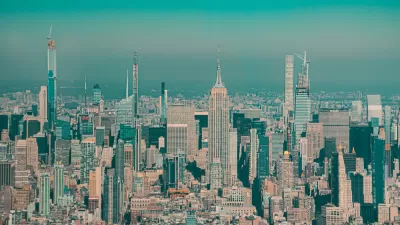Today in New York City, developers and public officials broke ground on the $15 billion Hudson Yards redevelopment project. Jason Sheftell reports on the milestone day and includes some stunning renderings of the project's components.
Building big is nothing new in the Big Apple, but this mega-project, which will create "more office space than exists in Portland, Ore." on 26 acres located atop rail yards on Mahattan's far west side, "will be the largest private real estate development in the history of New York." The completion of the project's 15 buildings will change the face of Midtown Manhattan, and the city as a whole.
“'This will shift the heart of the city to the Far West Side,' said Stephen Ross, whose Related Companies partnered with Oxford Properties Group to develop the site bounded by 30th St., Tenth Ave., 33rd St. and the West Side Highway. 'If you look at where all the young people are today, where they want to be, where all the money is going, it’s the West Side of Manhattan,' Ross, the Related chairman, added. 'The yards will be the epicenter of all that.'"
"Urban experts see Hudson Yards as a means for New York to stay competitive with Shanghai, London and Paris as a key 21st century city," says Sheftell. “This city needs to prove it can continue to innovate,” said Mitchell Moss, a New York University urban policy professor. “Who would figure out how to build a new neighborhood on railroad yards? People overlook that it brings a new class of buildings that are the most technologically and environmentally advanced. That’s key to attracting major companies, events and people.”
"The first phase will include four mixed-use commercial, residential, and retail structures, a cultural center and a five-star hotel."
FULL STORY: New York City officials, developers to break ground on $15 billion mini-city Hudson Yards

Maui's Vacation Rental Debate Turns Ugly
Verbal attacks, misinformation campaigns and fistfights plague a high-stakes debate to convert thousands of vacation rentals into long-term housing.

Planetizen Federal Action Tracker
A weekly monitor of how Trump’s orders and actions are impacting planners and planning in America.

In Urban Planning, AI Prompting Could be the New Design Thinking
Creativity has long been key to great urban design. What if we see AI as our new creative partner?

Portland Raises Parking Fees to Pay for Street Maintenance
The city is struggling to bridge a massive budget gap at the Bureau of Transportation, which largely depleted its reserves during the Civd-19 pandemic.

Spokane Mayor Introduces Housing Reforms Package
Mayor Lisa Brown’s proposals include deferring or waiving some development fees to encourage more affordable housing development.

Houston Mayor Kills Another Bike Lane
The mayor rejected a proposed bike lane in the Montrose district in keeping with his pledge to maintain car lanes.
Urban Design for Planners 1: Software Tools
This six-course series explores essential urban design concepts using open source software and equips planners with the tools they need to participate fully in the urban design process.
Planning for Universal Design
Learn the tools for implementing Universal Design in planning regulations.
Gallatin County Department of Planning & Community Development
Heyer Gruel & Associates PA
JM Goldson LLC
City of Camden Redevelopment Agency
City of Astoria
Transportation Research & Education Center (TREC) at Portland State University
Jefferson Parish Government
Camden Redevelopment Agency
City of Claremont





























